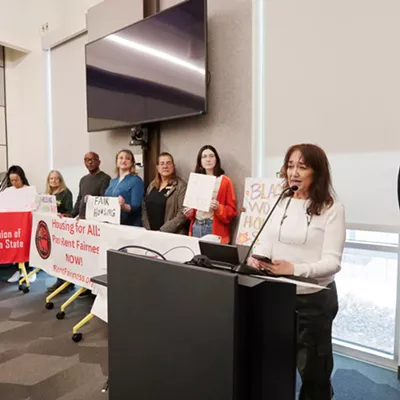SG - Green Projects
[
{
"name": "Broadstreet - Instory",
"component": "25846487",
"insertPoint": "4",
"requiredCountToDisplay": "4"
},{
"name": "Broadstreet - Empower Local",
"component": "27852456",
"insertPoint": "8",
"requiredCountToDisplay": "8"
},{
"name": "Broadstreet - Instory",
"component": "25846487",
"insertPoint": "12",
"requiredCountToDisplay": "12"
},{
"name": "Broadstreet - Instory - 728x90 / 970x250",
"component": "27852677",
"insertPoint": "18",
"requiredCountToDisplay": "18"
},{
"name": "Broadstreet - Instory",
"component": "25846487",
"insertPoint": "5th",
"startingPoint": "23",
"requiredCountToDisplay": "24",
"maxInsertions": 100
}
]
by Kevin Taylor & r & & r & Summer's a great time to take on a home improvement project, with nice weather and extra hours of sunlight. This summer, maybe it's finally time to do some projects that reflect the green ethic of using less. Even minor changes can add up to make big differences.
Eat Your Yard & r & & lt;span class= "dropcap " & I & lt;/span & t's no longer "breaking news" that a lush, weedless deep-green lawn comes at an environmental cost. The average homeowner tends to use more herbicides and pesticides per square foot than does the average farmer. The mowing -- while arguably brief -- consumes gas, creates exhaust, and almost all the clippings are shipped off to the dump where we don't have to think about what happens next.
And then there's all that water.
Even in an area blessed with a robust aquifer, alarm bells are already going off to warn that the supply is not unlimited.
I like lush green lawns. I even wish, when I can bear to look at my hard-packed and weed-choked lot in an older and poor Spokane neighborhood, that I had one.
It'll come, but it won't be the main feature. Ever since I stumbled across Rosalind Creasy's Edible Landscaping, I've cut way back on grass.
Creasy's book was published a quarter century ago, and all the preachy "green living" guides are still offering her vision today. Talk about reuse and recycle. In the newer books, even some of her crazier bits are being touted -- replace your lawn with chamomile? A few eye-rolls aside, Creasy offers terrific ideas for replacing your boring lawn with stuff that not only looks good, but is good to eat and makes good environmental sense.
One of the best bits in her book addresses plants that make great landscaping attractions without being water hogs.
Even here in East Central (where the official motto used to be "More Neighbor Than Hood"), I have lined a long hot stretch of sidewalk with lavender and thyme and rosemary. It's pretty, it's fragrant and it thrives on very little water.
I've cut away segments of lawn to put in raised-bed vegetable gardens and usually have various vines -- cucumber or beans or peas -- climbing up a frame.
Happily, this prospect of bringing vegetables out from behind the garage can be seen more and more often around Spokane. One year, someone planted a row of corn in the otherwise virtually useless planting strip.
Made me green... with envy.
So look for Edible Landscaping in the library or bookstore and start nibbling away at your lawn and water bill.
Responsible Remodeling & r & & lt;span class= "dropcap " & S & lt;/span & o there's that list -- written down or stored in your head -- of all the things you're going to do to the homestead to make it one sweet little Ponderosa.
Reviewing such a list is great. It's like endorphin: The glossy, full-color images of what it's going to look like completely obscure the reality of the horrid brown carpet in the dim living room -- was it that exact brown when I bought the place? -- the single plug-in that serves the entire dining room, the fist-sized gob of silicone that was a previous owner's answer to a kitchen plumbing crisis.
But now it's hair-of-the-dog time (especially for the carpet). For years, books, magazines and do-it-yourself TV shows have presented segments on green remodeling. But we live in Spokane. Are low-VOC/no-VOC paints even legal in this town? Can you say "earth-friendly" without getting sued by the county commissioners?
It turns out that not only is there a Northwest Eco Building Guild in the city (our version of an underground resistance cell), but there are remodelers willing to go green -- even if the materials and techniques aren't mainstream. There's even a store where you can buy all the free-range organic building materials you need.
Bruce Gage and his sister Nadine Sullivan run the Eco Depot near Sprague and Sullivan in Spokane Valley. They are in the midst of negotiating relocation to Sprague and Perry to help green up one of Spokane's more neglected business districts. The move could happen this summer.
Gage is the kind of guy who likes to walk his talk. He's in the middle of a massive remodel of his East Central neighborhood home, and he's turning the joint into a laboratory for green techniques.
He does more than you or I might. In fact, he's a maniac. He replumbed his house for a solar hot-water system, installing a panel on the roof and a storage tank in the basement. He's heating the house with free waste vegetable oil from the restaurant next door to Eco Depot. The oil is free, but a brand-new waste-oil burner cost $9,000.
But let's say I finally rip out the brown carpet. If the wood underneath is decent (it'll be fir, if it's like the rest of the house) it can be refinished with a sealer that's low-VOC (for "volatile organic compounds" -- which come mainly from petroleum-based products).
If I want something that's in the same price range as other floors but snazzier, there's bamboo flooring -- it's a grass, not timber, and therefore qualifies as sustainable. There are also planet-friendly linoleums (no vinyl) along with countertop materials and tiles made from recycled glass.
Low-VOC paints are also available, though only in shades of dun and gray. (Kidding!)
So instead of going to the big-box outlets and getting the same stuff every other remodeler in Spokane is getting, for the same money you can get something sustainable and different.
You'll make your neighbors green with envy.
Green Homebuilding & r & & lt;span class= "dropcap " & S & lt;/span & ome of us would like to be more Earth-friendly, but we don't have 10,000 acres in Montana and a tribe of rugged yet gentle friends to help us build that perfect straw-bale house with the view of the mountains.
Or, we don't have the passive-solar ATM machine to get us the cash to buy the above.
Breathe! Center! There is help.
Groundbreaking Spokane architect Kelly Lerner recently won a prestigious United Nations World Habitat Award (presented in Jakarta) for building more than 600 straw-bale houses and three straw-bale schools in northeastern China last year. She's done projects in China for nearly a decade, bringing the tools of energy efficiency and use of sustainable building materials to an overcrowded country ripping low-sulfur coal out of the ground by the ton and burning it despite the pollution hazards.
Each straw-bale house reduces energy needs by 68 percent, helping to reduce carbon dioxide emissions, and letting families spend more money on food or school.
This is the same sensibility -- helping the planet and helping the person -- Lerner brings home to Spokane. She and fellow architect Carol Venolia have just completed a book (which comes out on June 28), Natural Remodeling for the Not-So-Green House -- Bringing Your Home Into Harmony With Nature.
"We all live in not-so-green houses," Lerner says.
The book is more of a why to, than a how-to.
Like why building the earth house on previously undisturbed land may be less green than remodeling the Spokane ranchette with an eye on energy savings, sustainable materials, cleaner indoor air and feeling more connected to the world.
"We all start from where we are," Lerner says.
Working with an existing building, she says, takes fewer resources, doesn't destroy undisturbed land, saves money both on the project and later in energy costs. And it uses existing infrastructure.
(Pssst, someone pass this along to the Spokane County commissioners.)
The book contains one of Lerner's kitchen remodels that showcases cork flooring, salvaged Doug fir woodwork, wheatboard cabinets and a lime-based paint that doesn't exhale any hazardous fumes.
There are plenty of checklists and resource guides to go with the glossy photos.
Just as higher gasoline prices are prompting changeovers from SUVs to fuel-efficient cars, rising energy prices will induce eco-friendly remodels, Lerner says.
Even in Spokane. "I think it's taking off in a huge way. People are concerned about their health, and concerned about energy and about the value of their houses."
And she's more convinced than ever that green remodeling can accomplish all three of the above.
"Now I can say I wrote the book on it," she says.
Eat Your Yard & r & & lt;span class= "dropcap " & I & lt;/span & t's no longer "breaking news" that a lush, weedless deep-green lawn comes at an environmental cost. The average homeowner tends to use more herbicides and pesticides per square foot than does the average farmer. The mowing -- while arguably brief -- consumes gas, creates exhaust, and almost all the clippings are shipped off to the dump where we don't have to think about what happens next.
And then there's all that water.
Even in an area blessed with a robust aquifer, alarm bells are already going off to warn that the supply is not unlimited.
I like lush green lawns. I even wish, when I can bear to look at my hard-packed and weed-choked lot in an older and poor Spokane neighborhood, that I had one.
It'll come, but it won't be the main feature. Ever since I stumbled across Rosalind Creasy's Edible Landscaping, I've cut way back on grass.
Creasy's book was published a quarter century ago, and all the preachy "green living" guides are still offering her vision today. Talk about reuse and recycle. In the newer books, even some of her crazier bits are being touted -- replace your lawn with chamomile? A few eye-rolls aside, Creasy offers terrific ideas for replacing your boring lawn with stuff that not only looks good, but is good to eat and makes good environmental sense.
One of the best bits in her book addresses plants that make great landscaping attractions without being water hogs.
Even here in East Central (where the official motto used to be "More Neighbor Than Hood"), I have lined a long hot stretch of sidewalk with lavender and thyme and rosemary. It's pretty, it's fragrant and it thrives on very little water.
I've cut away segments of lawn to put in raised-bed vegetable gardens and usually have various vines -- cucumber or beans or peas -- climbing up a frame.
Happily, this prospect of bringing vegetables out from behind the garage can be seen more and more often around Spokane. One year, someone planted a row of corn in the otherwise virtually useless planting strip.
Made me green... with envy.
So look for Edible Landscaping in the library or bookstore and start nibbling away at your lawn and water bill.
Responsible Remodeling & r & & lt;span class= "dropcap " & S & lt;/span & o there's that list -- written down or stored in your head -- of all the things you're going to do to the homestead to make it one sweet little Ponderosa.
Reviewing such a list is great. It's like endorphin: The glossy, full-color images of what it's going to look like completely obscure the reality of the horrid brown carpet in the dim living room -- was it that exact brown when I bought the place? -- the single plug-in that serves the entire dining room, the fist-sized gob of silicone that was a previous owner's answer to a kitchen plumbing crisis.
But now it's hair-of-the-dog time (especially for the carpet). For years, books, magazines and do-it-yourself TV shows have presented segments on green remodeling. But we live in Spokane. Are low-VOC/no-VOC paints even legal in this town? Can you say "earth-friendly" without getting sued by the county commissioners?
It turns out that not only is there a Northwest Eco Building Guild in the city (our version of an underground resistance cell), but there are remodelers willing to go green -- even if the materials and techniques aren't mainstream. There's even a store where you can buy all the free-range organic building materials you need.
Bruce Gage and his sister Nadine Sullivan run the Eco Depot near Sprague and Sullivan in Spokane Valley. They are in the midst of negotiating relocation to Sprague and Perry to help green up one of Spokane's more neglected business districts. The move could happen this summer.
Gage is the kind of guy who likes to walk his talk. He's in the middle of a massive remodel of his East Central neighborhood home, and he's turning the joint into a laboratory for green techniques.
He does more than you or I might. In fact, he's a maniac. He replumbed his house for a solar hot-water system, installing a panel on the roof and a storage tank in the basement. He's heating the house with free waste vegetable oil from the restaurant next door to Eco Depot. The oil is free, but a brand-new waste-oil burner cost $9,000.
But let's say I finally rip out the brown carpet. If the wood underneath is decent (it'll be fir, if it's like the rest of the house) it can be refinished with a sealer that's low-VOC (for "volatile organic compounds" -- which come mainly from petroleum-based products).
If I want something that's in the same price range as other floors but snazzier, there's bamboo flooring -- it's a grass, not timber, and therefore qualifies as sustainable. There are also planet-friendly linoleums (no vinyl) along with countertop materials and tiles made from recycled glass.
Low-VOC paints are also available, though only in shades of dun and gray. (Kidding!)
So instead of going to the big-box outlets and getting the same stuff every other remodeler in Spokane is getting, for the same money you can get something sustainable and different.
You'll make your neighbors green with envy.
Green Homebuilding & r & & lt;span class= "dropcap " & S & lt;/span & ome of us would like to be more Earth-friendly, but we don't have 10,000 acres in Montana and a tribe of rugged yet gentle friends to help us build that perfect straw-bale house with the view of the mountains.
Or, we don't have the passive-solar ATM machine to get us the cash to buy the above.
Breathe! Center! There is help.
Groundbreaking Spokane architect Kelly Lerner recently won a prestigious United Nations World Habitat Award (presented in Jakarta) for building more than 600 straw-bale houses and three straw-bale schools in northeastern China last year. She's done projects in China for nearly a decade, bringing the tools of energy efficiency and use of sustainable building materials to an overcrowded country ripping low-sulfur coal out of the ground by the ton and burning it despite the pollution hazards.
Each straw-bale house reduces energy needs by 68 percent, helping to reduce carbon dioxide emissions, and letting families spend more money on food or school.
This is the same sensibility -- helping the planet and helping the person -- Lerner brings home to Spokane. She and fellow architect Carol Venolia have just completed a book (which comes out on June 28), Natural Remodeling for the Not-So-Green House -- Bringing Your Home Into Harmony With Nature.
"We all live in not-so-green houses," Lerner says.
The book is more of a why to, than a how-to.
Like why building the earth house on previously undisturbed land may be less green than remodeling the Spokane ranchette with an eye on energy savings, sustainable materials, cleaner indoor air and feeling more connected to the world.
"We all start from where we are," Lerner says.
Working with an existing building, she says, takes fewer resources, doesn't destroy undisturbed land, saves money both on the project and later in energy costs. And it uses existing infrastructure.
(Pssst, someone pass this along to the Spokane County commissioners.)
The book contains one of Lerner's kitchen remodels that showcases cork flooring, salvaged Doug fir woodwork, wheatboard cabinets and a lime-based paint that doesn't exhale any hazardous fumes.
There are plenty of checklists and resource guides to go with the glossy photos.
Just as higher gasoline prices are prompting changeovers from SUVs to fuel-efficient cars, rising energy prices will induce eco-friendly remodels, Lerner says.
Even in Spokane. "I think it's taking off in a huge way. People are concerned about their health, and concerned about energy and about the value of their houses."
And she's more convinced than ever that green remodeling can accomplish all three of the above.
"Now I can say I wrote the book on it," she says.
















